Scag Power Equipment Turf Storm User manual
- Category
- Lawnmowers
- Type
- User manual
This manual is also suitable for

PART NO. 03532
PRINTED 9/2022
PRINTED IN USA
© 2022
Scag Power Equipment
Division of Metalcraft of Mayville, Inc.
Congratulations on owning a Scag Sprayer/Spreader! This manual contains the
operating instructions and safety information for your Scag Sprayer/Spreader.
Reading this manual can provide you with assistance in maintenance and
adjustment procedures to keep your machine performing to maximum
efciency. The specic models that this book covers are listed on the inside
cover. Before operating your machine, please read all the information
enclosed.
OPERATOR’S
MANUAL
SPRAYER/
SPREADER
Models: STS60-23BV

WARNING
FAILURE TO FOLLOW SAFE OPERATING PRACTICES MAY RESULT
IN SERIOUS INJURY OR DEATH.
• Read this manual completely as well as other manuals that came with your sprayer/
spreader.
• DO NOT operate on steep slopes. To check a slope, attempt to back up it. If the
machine can back up the slope without the wheels slipping, reduce speed and use
extreme caution.
• Under no circumstances should the machine be operated on slopes greater than 15
degrees. ALWAYS FOLLOW OSHA APPROVED OPERATION.
• Weight in the storage tanks and hopper will transfer when on a slope, this may
cause a loss of traction or increased risk of a roll-over.
• When operating with a heavy load, reduce speed and allow sufficient braking
distance. Use extra caution on slopes.
• Liquid loads shift during operation, especially while turning, going up or down
slopes, sudden changes in speed or while driving over rough surfaces. Shifting
loads can cause the machine to tip over.
• Stay two machine widths away from slopes, drop offs, ditches, water,retaining walls,
avoid any slope exceeding 15 degrees.
• DO NOT operate on wet grass. Wet grass reduces traction and steering control.
• Keep all shields in place.
• Before performing any maintenance or service, stop the machine, remove the spark
plug wire(s), and remove the ignition key.
• If a mechanism becomes clogged, stop the engine before cleaning.
• Keep hands, feet, and clothing away from power-driven parts.
• Keep others off the machine (only one person at a time).
REMEMBER - YOUR SPRAYER/SPREADER IS ONLY AS SAFE AS THE
OPERATOR!
HAZARD CONTROL AND ACCIDENT PREVENTION ARE DEPENDENT UPON THE AWARENESS,
CONCERN, PRUDENCE, AND PROPER TRAINING OF THE PERSONNEL INVOLVED IN THE
OPERATION, TRANSPORT, MAINTENANCE, AND STORAGE OF THE EQUIPMENT.
This manual covers the operating instructions and illustrated parts list for:
STS60-23BV with a serial number of V9800001 to V9899999
Always use the entire serial number listed on the serial number tag when referring to this product.

I
R
Table of Contents
Table of Contents
NOTES .............................................................................................................................................................. IV
SECTION 1 - GENERAL INFORMATION ...................................................................................1
1.1 INTRODUCTION ...........................................................................................................................................1
1.2 DIRECTION REFERENCE ...........................................................................................................................1
1.3 SERVICING THE ENGINE AND DRIVE TRAIN COMPONENTS .................................................................1
1.4 SYMBOLS ....................................................................................................................................................2
SECTION 2 - SAFETY INFORMATION ......................................................................................3
2.1 INTRODUCTION ...........................................................................................................................................3
2.2 SIGNAL WORDS ..........................................................................................................................................3
2.3 BEFORE OPERATION CONSIDERATIONS ................................................................................................3
2.4 TESTING THE SAFETY INTERLOCK SYSTEM ..........................................................................................5
2.5 OPERATION CONSIDERATIONS ................................................................................................................5
2.6 MAINTENANCE CONSIDERATIONS & STORAGE ....................................................................................7
2.7 USING A SPARK ARRESTOR ..................................................................................................................... 8
2.8 SPARK IGNITION SYSTEM .........................................................................................................................8
2.9 CHEMICAL HAZARDS ................................................................................................................................8
2.10 SAFETY AND INSTRUCTIONAL DECALS .............................................................................................10
SECTION 3 - SPECIFICATIONS ..............................................................................................12
3.1 ENGINE ......................................................................................................................................................12
3.2 ELECTRICAL .............................................................................................................................................12
3.3 SPRAYER/SPREADER ..............................................................................................................................12
3.4 HYDRAULIC SYSTEM ...............................................................................................................................13
3.5 WEIGHTS AND DIMENSIONS ...................................................................................................................13
3.6 PRODUCTIVITY .........................................................................................................................................13
SECTION 4 - OPERATING INSTRUCTIONS ...........................................................................14
4.1 DIGITAL DISPLAY INSTRUMENT IDENTIFICATION ................................................................................ 14
4.2 CONTROLS IDENTIFICATION ..................................................................................................................16
4.3 SAFETY INTERLOCK SYSTEM ................................................................................................................17
4.4 TESTING THE SAFETY INTERLOCK SYSTEM ........................................................................................17
4.5 INITIAL RUN-IN PROCEDURES ................................................................................................................18
4.6 STARTING THE ENGINE ...........................................................................................................................18
4.7 GROUND TRAVEL AND STEERING .........................................................................................................19
4.8 OPERATING THE SPRAYER .....................................................................................................................20
4.9 OPERATING THE SPRAYER TANK VALVES ............................................................................................21
4.10 OPERATING THE SPRAYER BOOM .......................................................................................................22
4.11 OPERATING THE SPRAY WAND ............................................................................................................22
4.12 OPERATING THE SPREADER ................................................................................................................23
4.13 HILLSIDE OPERATION ............................................................................................................................26
4.14 PARKING THE MACHINE ........................................................................................................................27

II
R
Table of Contents
4.15 AFTER OPERATION ................................................................................................................................27
4.16 REMOVING CLOGGED MATERIAL ........................................................................................................27
4.17 MOVING MACHINE WITH ENGINE STOPPED .......................................................................................27
4.18 RECOMMENDATIONS FOR SPRAYING .................................................................................................27
4.19 RECOMMENDATIONS FOR SPRAYING WITH THE SPRAY WAND .......................................................28
4.20 RECOMMENDATIONS FOR SPREADING ..............................................................................................28
4.21 RECOMMENDATIONS FOR SPREADING AND SPRAYING AT THE SAME TIME ................................ 28
SECTION 5 - ADJUSTMENTS .................................................................................................29
5.1 PARKING BRAKE ADJUSTMENT ............................................................................................................29
5.2 TRAVEL ADJUSTMENT .............................................................................................................................29
5.3 THROTTLE CONTROL AND CHOKE ADJUSTMENTS ............................................................................31
5.4 BELT ADJUSTMENTS ...............................................................................................................................31
5.5 BELT ALIGNMENT .....................................................................................................................................31
5.6 OPERATOR CUSHION REMOVAL ............................................................................................................31
5.7 CALIBRATING THE SPRAYER .................................................................................................................. 32
5.8 CALIBRATING THE SPREADER ............................................................................................................... 33
5.9 ADDING SPRAY MIXTURE ........................................................................................................................35
5.10 SPREADING CHART ...............................................................................................................................36
BASED OFF OF 5 MPH ...................................................................................................................................36
ALL DIAL SETTINGS SHOULD BE USED AS A BASE, MANUAL CALIBRATION IS BEST .......................36
5.11 SPRAY NOZZLE CHART (AI TEEJET)
AI110025 (lavendar) nozzle (0.34 US Gallons per 1,000 sq/ft) are installed as standard equipment
All calculations based off of 100" effective spray width (All 5 Nozzles Activated) .............................................37
SECTION 6 - MAINTENANCE ..................................................................................................41
6.1 MAINTENANCE CHART - RECOMMENDED SERVICE INTERVALS ......................................................41
6.2 LUBRICATION ............................................................................................................................................42
6.3 HYDRAULIC SYSTEM ...............................................................................................................................44
6.4 ENGINE OIL ...............................................................................................................................................45
6.5 ENGINE FUEL SYSTEM ............................................................................................................................46
6.6 ENGINE AIR CLEANER .............................................................................................................................47
6.7 BATTERY - ELECTRIC START MODELS..................................................................................................47
6.8 DRIVE BELTS .............................................................................................................................................48
6.9 TIRES .......................................................................................................................................................... 48
6.10 BODY ........................................................................................................................................................ 48
6.11 SPRAYER MAINTENANCE .....................................................................................................................48
6.12 SPREADER MAINTENANCE...................................................................................................................51

III
R
Table of Contents
SECTION 7 - ILLUSTRATED PARTS LIST ..............................................................................53
7.1 SCAG APPROVED ATTACHMENTS AND ACCESSORIES. .....................................................................53
SPRAYER BOOM ASSEMBLY ........................................................................................................................54
SPRAYER SYSTEM .........................................................................................................................................56
220# HOPPER ASSEMBLY .............................................................................................................................58
SHEET METAL COMPONENTS ......................................................................................................................60
STEERING CONTROLS ...................................................................................................................................62
FUEL SYSTEM ................................................................................................................................................. 64
HYDRAULICS AND ENGINE COMPONENTS ................................................................................................66
ELECTRICAL SYSTEM ...................................................................................................................................68
HYDRAULIC PUMP ..........................................................................................................................................70
SPRAYER PUMP ..............................................................................................................................................72
REPLACEMENT DECALS AND INFORMATION PLATES .............................................................................74
STS ELECTRICAL SCHEMATIC .....................................................................................................................76
LIMITED WARRANTY - TURF STORM SPRAYER/SPREADER .................................... INSIDE BACK COVER

IV
R
Table of Contents
NOTES

1
R
Section 1
1.1 INTRODUCTION
Your sprayer/spreader was built to the highest standards
in the industry. However, the prolonged life and maximum
efficiency of your sprayer/spreader depends on you
following the operating, maintenance and adjustment
instructions in this manual.
If additional information or service is needed, contact your
Scag Power Equipment Dealer.
We encourage you to contact your dealer for repairs. All
Scag dealers are informed of the latest methods to service
this equipment and provide prompt and efficient service in
the field or at their service shop. They carry a full line of
Scag service parts.
THE REPLACEMENT OF ANY PART ON THIS PRODUCT
BY OTHER THAN THE MANUFACTURER'S AUTHORIZED
REPLACEMENT PART MAY ADVERSELY AFFECT THE
PERFORMANCE, DURABILITY OR SAFETY OF THIS
PRODUCT.
USE OF OTHER THAN ORIGINAL SCAG REPLACEMENT
PARTS WILL VOID THE WARRANTY.
When ordering parts, always give the model and serial
number of your sprayer/spreader. The serial number plate
is located where shown in Figure 1-1.
Serial Number
Plate Location
Figure 1-1. Sprayer Spreader Serial Number Location
GENERAL INFORMATION
USE ONLY SCAG APPROVED ATTACHMENTS AND
ACCESSORIES.
Attachments and accessories manufactured by companies
other than Scag Power Equipment are not approved for use
on this machine. See Section 8, Paragraph 7-1. Be aware
that using attachments with the mower may affect stability.
Be sure to follow the directions found in the operator's
manual.
WARNING
For pictorial clarity, some illustrations and figures
in this manual may show shields, guards or plates
open or removed. Under no circumstances should
your sprayer/spreader be operated without these
devices in place.
All information is based upon product information available
at the time of approval for printing. Scag Power Equipment
reserves the right to make changes at any time without
notice and without incurring any obligation.
1.2 DIRECTION REFERENCE
The “Right” and “Left”, “Front” and “Rear” of the machine
are referenced from the operator’s right and left when
standing in the normal operating position and facing the
forward travel direction.
1.3 SERVICING THE ENGINE AND DRIVE
TRAIN COMPONENTS
The detail servicing and repair of the engine, hydraulic
pumps, and sprayer pumps are not covered in this manual;
only routine maintenance and general service instructions
are provided. For service of these components during
the limited warranty period, it is important to contact your
Scag dealer or find a local authorized servicing agent of
the component manufacturer. Any unauthorized work done
on these components during the warranty period may void
your warranty.

2
R
Section 1
1.4 SYMBOLS
SYMBOL DESCRIPTION SYMBOL DESCRIPTION
Choke
Hour meter/Elapsed Operating Hours
Parking Brake Keep Bystanders Away
On/Start
Transmission
Off/Stop
Spring Tension on Idler
Falling Hazard
Oil
Fast
Thrown Object Hazard
Continuously Variable - Linear Slow
481039S
Pinch Point Read Operator's Manual

3
R
Section 2
2.1 INTRODUCTION
Your machine is only as safe as the operator. Carelessness
or operator error may result in serious bodily injury or death.
Hazard control and accident prevention are dependent
upon the awareness, concern, prudence, and proper
training of the personnel involved in the operation, transport,
maintenance and storage of the equipment. Make sure
every operator is properly trained and thoroughly familiar
with all of the controls before operating the machine. The
owner/user can prevent and is responsible for accidents or
injuries occurring to themselves, other people or property.
READ THIS OPERATOR’S MANUAL BEFORE
ATTEMPTING TO START YOUR MACHINE. MAKE SURE
THAT EVERYONE KNOWS WHERE THE MANUAL IS
LOCATED AND KEEP A RECORD OF EACH EMPLOYEE
THAT HAS READ THE MANUAL.
A replacement manual is available from your authorized
Scag Service Dealer or by contacting Scag Power
Equipment, Service Department at P.O. Box 152, Mayville,
WI 53050 or contact us via the Internet at www.scag.com.
The manual for this machine can be downloaded by using
the model and serial number or use the contact form to
make your request. Please indicate the complete model
and serial number of your Scag product when requesting
replacement manuals.
2.2 SIGNAL WORDS
This symbol means “Attention! Become Alert! Your
Safety is Involved!" The symbol is used with the following
signal words to attract your attention to safety messages
found on the decals on the machine and throughout this
manual. The message that follows the symbol contains
important information about safety. To avoid injury and
possible death, carefully read the message! Be sure to fully
understand the causes of possible injury or death.
SIGNAL WORD:
It is a distinctive word found on the safety decals on the
machine and throughout this manual that alerts the viewer
to the existence and relative degree of the hazard.
DANGER
The signal word “DANGER” denotes that an extremely
hazardous situation exists on or near the machine that
could result in high probability of death or irreparable injury
if proper precautions are not taken.
WARNING
The signal word “WARNING” denotes that a hazard exists
on or near the machine that can result in injury or death if
proper precautions are not taken.
CAUTION
The signal word “CAUTION” is a reminder of safety practices
on or near the machine that could result in personal injury
if proper precautions are not taken.
Your safety and the safety of others depends significantly
upon your knowledge and understanding of all correct
operating practices and procedures of this machine.
2.3 BEFORE OPERATION
CONSIDERATIONS
WARNING
Check all hydraulic connections for tightness.
Inspect all hydraulic hoses and / or lines to ensure
they are in good condition before operating.
1. NEVER allow children to operate this machine. Do
not allow adults to operate this machine without
proper instructions.
2. Do not operate without the required state fertilizer
applicator license or other applicable licenses (vary
by state).
SAFETY INFORMATION

4
R
Section 2
3. Do not spray when children and/or others are
present. Keep children out of the spraying area and
in the watchful care of a responsible adult other than
the operator. Be alert and turn machine off if a child
enters the area.
4. DO NOT allow children to ride or play on the
machine, it is not a toy.
5. Keep keys stored in a safe location when the mower
is not in use; i.e. where they are inaccessible to
children.
6. Clear the area to be sprayed of objects that could be
contaminated with chemicals.
7. DO NOT carry passengers.
8. DO NOT operate the machine under the influence of
alcohol or drugs.
9. If the operator(s) or mechanic(s) cannot read
English, it is the owner's responsibility to explain this
material to them.
10. DO NOT wear loose fitting clothing. Loose clothing,
jewelry or long hair could get tangled in moving
parts. Do not operate the machine wearing shorts;
always wear adequate protective clothing including
long pants. Wear eye protection, gloves and any
other personnel protection equipment (PPE) that are
required by some local ordinances and insurance
regulations.
WARNING
Always wear hearing protection. Operating this
machine over prolonged periods of time can
cause loss of hearing.
11. Keep the machine and attachments in good
operating condition. Keep all shields and safety
devices in place. If a shield, safety device or decal
is defective or damaged, repair or replace it before
operating the machine.
12. Fuel is flammable; handle it with care. Fill the fuel
tank outdoors. Never fill it indoors. Use a funnel or
spout to prevent spillage. Clean up any spillage
before starting the engine.
13. DO NOT add fuel to a running or hot engine. Allow
the engine to cool for several minutes before adding
fuel. Never fuel indoors or inside enclosed trailers.
14. DO NOT start the engine until any spilled fuel has
been cleaned up or has evaporated.
15. Keep flammable objects (cigarettes, matches, etc.),
open flames and sparks away from the fuel tank and
fuel container. Use only approved containers.
16. Equipment must comply with the latest requirements
per SAE J137 and/or ANSI/ASAE S279 when driven
on public roads.
17. Make sure all hydraulic fluid connections are tight
and all hydraulic hoses and lines are in good
condition before starting the machine.
WARNING
This machine is equipped with an interlock system
intended to protect the operator and others from
injury. This is accomplished by preventing the
engine from starting unless the parking brake
is engaged, the steering control levers are in the
neutral position and the operator is in the operator
position. The interlock system shuts off the engine
if the operator leaves the operator platform with
the steering control levers not in the neutral
position and the parking brake not engaged.
18. Be sure the interlock switches are functioning
correctly.
19. Make sure to handle all chemicals according to the
manufacturers directions.
20. Use proper protective equipment to protect yourself
from chemical exposure (rubber boots, respirator,
chemical resistant gloves, and safety glasses/
goggles). Do not store protective equipment with or
near chemicals.
21. Do not operate this machine if the proper chemical
safety information/equipment is not present.
22. When preparing to work on the sprayer or spreader
system, make sure to thoroughly flush the system
(refer to manufacturer's recommendations for
neutralizing the chemical).
23. Always follow the chemical manufacturer's
instructions for application and safety.

5
R
Section 2
2.4 TESTING THE SAFETY INTERLOCK
SYSTEM
The safety interlock system should be tested each time
before using the machine. If the safety interlock system
does not operate as described below, contact your local
Authorized Scag Power Equipment Dealer immediately to
have the safety interlock system repaired.
-NOTE-
The machine will not start with the operator off
of the platform. For all test procedures listed
below, the engine must be started with the
operator standing on the platform unless specified
otherwise.
1. Place the spreader switch to the OFF (down)
position, release the parking brake. Stand on the
operator platform in the operating position. Try to
start the engine; the engine should not start.
2. Place the steering control levers in the neutral
position, engage the parking brake, move the
spreader switch to the OFF (down) position, and
start the engine. Stand on the operator platform
in the operating position with the engine running,
engage the spreader switch to the ON (up) position,
and step backwards off of the operating platform.
The spreader should shut off and the engine should
stay running.
3. Stand on the operator platform in the operating
position, place the steering control levers in the
neutral position, engage the parking brake, move
the spreader switch to the OFF (down) position, and
start the engine. With the engine running, release
the parking brake, and step backwards off of the
operating platform. The engine should shut off.
4. Stand on the operator platform in the operating
position, place the steering control levers in the
neutral position, engage the parking brake, move
the sprayer switch to the OFF (down) position, and
start the engine. With the engine running, move
the sprayer switch to the ON (up) position, release
the parking brake, and step backwards off of the
operating platform. The engine should shut off and
the sprayer pump should stay running.
5. Stand on the operator platform in the operating
position, place the steering control levers in the
neutral position, engage the parking brake, move
the sprayer switch to the OFF (down) position, and
start the engine. With the engine running, move the
sprayer switch to the ON (up) position, and step
backwards off of the operating platform. The engine
and sprayer pump should stay running.
2.5 OPERATION CONSIDERATIONS
1. Know the function of all controls and how to stop
quickly.
WARNING
DO NOT operate on steep slopes. Under no
circumstances should the machine be operated
on slopes greater than 15 degrees. See Figure 2-3,
Page 11 to determine approximate slope of area to
be sprayed. ALWAYS FOLLOW OSHA APPROVED
OPERATION.
2. Reduce speed and exercise extreme caution on
slopes and in sharp turns to prevent tipping or loss
of control. Be especially cautious when changing
directions on slopes.
3. Stay two machine widths away from slopes, drop
offs, ditches, water, retaining walls avoid any slope
exceeding 15-degrees.
4. To prevent tipping or loss of control, start and stop
smoothly, avoid unnecessary turns and travel at
reduced speed.
5. Immediately apply the parking brake if you lose
steering control while operating. Inspect the machine
and correct the problem before continuing to operate.
6. When using any attachment, never direct the
chemical and/or material toward bystanders or allow
anyone near the machine while in operation.
7. Start the engine with the operator in the operating
position, the sprayer/spreader disengaged, parking
brake is engaged, and the neutral lever is in neutral.
8. If the machine sprayer/spreader system ever plugs,
shut off the engine, remove the ignition key, and
wait for all movement to stop before removing any
obstructions. (use proper personnel protective
equipment (PPE) while working with any chemicals.)

6
R
Section 2
WARNING
DO NOT use your hand to dislodge a clogged
hopper dump chute. Use a stick or other device
to remove clogged material after the engine has
stopped running and the impeller has stopped
turning.
9. Be alert for holes, rocks, roots and other hidden
hazards in the terrain. Keep away from any drop
offs. Beware of overhead obstructions (low limbs,
etc.), underground obstacles (sprinklers, pipes, tree
roots, etc.). Cautiously enter a new area. Be alert for
hidden hazards.
10. Be sure to keep the machine away from water or
other hazards (avoid spraying any chemicals near
water to avoid water contamination).
11. Be aware that spreader material and liquid material
may shift while turning or suddenly changing speed.
This can cause the unit to tip over or lose control.
12. Disengage power to the sprayer/spreader before
backing up. Do not spray/spread in reverse unless
absolutely necessary and then only after observation
of the entire area behind the machine. If you must
spray/spread in reverse, maintain a constant
lookout to the rear of the machine and spray/spread
carefully.
13. DO NOT turn sharply. Use care when backing up.
14. Disengage power to the sprayer/spreader before
crossing roads, walks or gravel drives.
15. Spray/spread only in daylight or good artificial light.
16. Take all possible precautions when leaving the
machine unattended, such as disengaging the
machine, stopping the engine, and removing the key.
17. Disengage power to the attachments when
transporting or when not in use.
18. Always point spray wand in a safe direction, spray
wand can become highly pressurized and cause
injury if not handled safely.
19. Do not disconnect the spray wand while system is
still pressurized.
20. Do not direct spray nozzles or spreader toward
people, pets, or electrical equipment. When draining
do not let chemicals come in contact with organic
material or your skin.
21. The machine and attachments should be stopped
and inspected for damage after striking a foreign
object, and damage should be repaired before
restarting and operating the machine.
CAUTION
Do not touch the engine or the muffler while the
engine is running or immediately after stopping.
These areas may be hot enough to cause a burn.
DANGER
DO NOT run the engine inside a building or
a confined area without proper ventilation.
Exhaust fumes are hazardous and contain carbon
monoxide which can cause brain injury and death.
22. Keep hands and feet away from moving parts.
Contact can injure.
23. Transport the machine using a heavy duty trailer
or truck. Ensure the trailer or truck has all of the
necessary lighting and markings as required by
laws, codes, and ordinances. Secure a trailer with a
safety chain.
24. Be cautious when loading and unloading onto
trailers or trucks. Use only a full width ramp. Always
back on and drive off a trailer.
25. When transporting the machine, make sure the
neutral lock lever is in neutral lock position, the
engine is off with the key removed, the parking brake
is engaged and the wheels have been blocked.
26. Tie the machine down securely using the tie down
points located on the front and rear of the machine.
See Figure 2-2 and 2-3. Secure using straps, chains,
cables, or ropes. Both front and rear straps must be
directed down and outward from machine.

7
R
Section 2
TIE DOWN
POINT
TIE DOWN
POINT
Figure 2-2. Front Tie Down Points
TIE DOWN
POINT
TIE DOWN
POINT
Figure 2-3. Rear Tie Down Points
27. Use care when approaching blind corners, shrubs,
trees, or other objects that may obscure vision.
28. NEVER leave the machine running unattended.
29. Always wash your hands or exposed areas after
contact with chemicals.
30. If a chemical spill occurs, make sure to refer to the
chemical manufacturer's recommendations for clean
up / neutralization.
31. When changing chemicals, always make sure to
rinse the system thoroughly, following the chemical
manufacturer's instructions for neutralizing the
chemical.
2.6 MAINTENANCE CONSIDERATIONS &
STORAGE
1. Never make adjustments to the machine with the
engine running unless specifically instructed to do
so. If the engine is running, keep hands, feet, and
clothing away from moving parts.
2. Place the control levers in the neutral position,
engage the parking brake, stop engine and remove
key or disconnect spark plug wire(s) to prevent
accidental starting of the engine when servicing or
adjusting the machine. Wait for all movement to stop
before adjusting, cleaning or repairing.
3. Remove spark plug wire(s) before making any
repairs.
4. Keep all nuts, bolts and screws tight, to ensure the
machine is in safe working condition. Check spray
nozzles and hoses frequently to be sure they are
tight.
5. Do not change the engine governor settings or
overspeed the engine. See the engine operator's
manual for information on engine settings.
6. To reduce fire hazard, keep drives, muffler, and
engine free of grass, leaves, excessive grease, oil
and dirt.
7. Park the machine on level ground.
8. NEVER allow untrained personnel to service the
machine.
9. Use care when checking the sprayer/spreader
system, make sure to use proper protective
equipment when working with areas that are
exposed to chemicals.
10. Keep all parts in good working condition. Replace all
worn or damaged decals.
11. Use jack stands to support components when
required.
12. Carefully release pressure from components with
stored energy.
WARNING
The spray system traps liquid under high
pressure, even when the engine is off. High
pressure discharge could cause serious injury
or death.

8
R
Section 2
WARNING
Hydraulic fluid is under high pressure and can
penetrate skin causing injury. If hydraulic fluid
is injected into the skin, it must be surgically
removed within a few hours by a doctor or
gangrene may result.
Keep body and hands away from pinholes or
nozzles that eject hydraulic fluid under high
pressure. Use paper or cardboard and not hands
to search for leaks.
Safely relieve all pressure from the hydraulic
system by placing the control levers in the neutral
lock position and shutting off the engine before
performing any work on the hydraulic system.
If you need service on your hydraulic system,
please see your authorized Scag dealer.
13. Let the engine cool before storing.
14. DO NOT store the machine near an open flame.
15. Shut off fuel while storing or transporting.
16. DO NOT store fuel near flames or drain indoors.
2.7 USING A SPARK ARRESTOR
The engine in this machine is not equipped with a spark
arrestor muffler. It is in violation of California Public
Resource Code Section 4442 to use or operate this engine
on or near any forest covered, brush covered or grass
covered land unless the exhaust system is equipped with
a spark arrestor meeting any applicable local or state laws.
Other states or federal areas may have similar laws. Check
with your state or local authorities for regulations pertaining
to these requirements.
2.8 SPARK IGNITION SYSTEM
This spark ignition system complies with Canadian
ICES-002.
2.9 CHEMICAL HAZARDS
Chemical substances used in the Turf Storm sprayer /
spreader may be hazardous to the operator, bystanders,
animals, soils, plants or other property.
1. Carefully read and follow the chemical warnings and
the MSDS (Material Safety Data Sheets) for each
chemical being used and protect yourself according
to the chemical manufacturer's recommendations.
2. Make sure as little skin as possible is exposed while
using chemicals.
3. Make sure to wear proper protective equipment
(PPE) when handling chemicals to guard against
personnal contact such as;
• Safety glasses, goggles and/or face shield
• Chemical resistant gloves
• Rubber boots or substantial footwear
• Hearing protection
• Respirator or filtered mask.
4. Keep a clean change of clothes, soap, and
disposable towels on-hand in the event of a chemical
spill.
5. Maintain a source of clean water to rinse off in case
of a spilled chemical.
6. Obtain proper training before using or handling
chemicals.
7. Use the correct chemicals for the job.
8. Follow the chemical manufacturer's instructions for
the safe application of the chemical being used. Do
not exceed the recommended system application
pressure.
9. Always make sure to dispose of chemicals according
to the manufacturer's disposal directions.
10. Have clean water available, especially when filling
the sprayer tanks.
11. Always handle chemicals in a well ventilated area.
12. Do not eat, drink, or smoke while working with or
handling chemicals.
13. Wash your hands and other exposed areas as soon
as possible after finishing the work.
14. Keep the chemicals in their original packaging and is
a safe location.

9
R
Section 2
15. Do not blow the spray nozzles out with your mouth,
nozzles should not be place in or near your mouth at
any time. (nozzles may have chemical residue.)
16. Make sure the machine is always rinsed off
thoroughly before working on it.
17. Do not put your mouth or face over the spray tank
openings. Chemicals and fumes are dangerous
18. If you are using more than one (1) chemical, read
the information for each. Refuse to operate or work
on the sprayer / spreader if the information is not
available.
19. Before working on the sprayer / spreader system,
ensure that that the system has been properly
cleaned, rinsed (See Sections 6.11 and 6.12)
and neutralized according to the manufacturer(s)
recommendations.
20. Verify there is an adequate supply of clean water
and soap nearby and immediately wash if any
chemicals come in contact with you.

10
R
Section 2
2.10 SAFETY AND INSTRUCTIONAL DECALS
2021 STS Safety Decals
Molded in Fuel Tank
486446

11
R
Section 2
5o
10o
15o
20o
0o
5o
10o
15o
0o
Figure 2-4. Slope Angle Graph

12
R
Section 3
SPECIFICATIONS
3.1 ENGINE
General Type ................................................................................................Heavy Duty Industrial/Commercial Gasoline
Model:
Scag Model STS60-23BV ............................................................................................ Briggs and Stratton Vanguard
Displacement:
Briggs and Stratton ............................................................................................................................................. 627cc
Type .......................................................................................................... 4 Cycle Gasoline, Twin Cylinder, Vertical Shaft
Cylinders ..................................................................................................................................... 2 with Cast Iron Sleeves
Governor ........................................................................Mechanical Type with Variable Speed Control Set At 3600 RPM
Idle Speed:
Briggs and Stratton ...................................................................................................................................... 1750 RPM
Fuel Pump ...................................................................................................... Integral Fuel Pump with In-Line Fuel Filter
Fuel ...................................................................................... Non-Leaded Gasoline with a Minimum Octane Rating of 87
Oil Pump ........................................................................................................................ Positive Displacement Gerotor™
Starter: .............................................................................................................. Electric Starting with Bendix Shift Starter
Belts .................................................................................................................Kevlar cord. Self-adjusting, Self-tightening
3.2 ELECTRICAL
Battery .................................................................................................................................................................... 12 Volt
Charging System ............................................................................................................................................... Alternator
Charging Output:
Briggs and Stratton ..............................................................................................................................12 Volt, 50 Amp
System Polarity ....................................................................................................................................... Negative Ground
Starter .......................................................................................................12 Volt Electric Ring Gear Type, Key Operated
Interlock Switches ............................................................................ Operator Presence, Parking Brake, Spreader Motor
Instrument Panel .......Key Switch, Throttle Lever, Choke, Foamer Switch (optional), Sprayer Pressure,Hopper Controls
Sprayer Switch, Spreader Switch, Hourmeter, Spreader Motor Speed Potentiometer, Digital Display
Fuses .....................................................................................................................................................Three (3) 20 Amp
3.3 SPRAYER/SPREADER
Drive System ............................................................................. Hydraulic Drive with Two Variable Displacement Pumps
and Two Cast-Iron High Torque Wheel Motors
Hydraulic Pumps ......................................................................................................... Two Hydro-Gear PG Series 10 cc.
with Dump Valves for movement without the engine running
Hydraulic Drive Motors .............................................................................Two Parker Model TG Cast-Iron Wheel Motors
Steering/Travel Control ..............................................Twin Lever Steering Control with Individual Control to Each Wheel
Parking Brake ...........................................................................Lever Actuated Linkage to Brakes on Both Drive Wheels
Wheels:
(2) Front Caster ................................................................................................16 x 6.5-8 Flat Free w/Roller Bearings
(2) Drive - ............................................................................ 20 X 12-10 Four-Ply Pneumatic Tubeless, Radius Edge
Tire Pressure:
Front Caster....................................................................................................................................................... 20 PSI
Drive .................................................................................................................................................................. 12 PSI
Fuel Tank .................... Single 5 Gallon Seamless Roto-Low Perm. Tank with Large Opening,Fuel Gauge and Fuel Cap
Foamer Tank (optional) .................................................................................. Single 1 Gallon Seamless with Valved Cap
Sprayer Capacity .......................................................................Two - 30 Gallon (60 gallons total)Tanks with Valved Cap
Spreader Capacity ................................................................................................................................... 220# with Cover
Travel Speed:
Forward .............................................................................................................................................. 0 up to 8.5 MPH
Reverse ................................................................................................................................................. 0 up to 5 MPH
-NOTE- The machine will travel up to 8 mph for transport purposes. For best spraying performance the forward
travel speed should be adjusted depending upon the chemical being applied.

13
R
Section 3
3.4 HYDRAULIC SYSTEM
Hydraulic Oil Filter ......................................................................................................... 10 Micron Spin-on Element Type
Hydraulic Expansion Reservoir ................................................................................................................................Nylon
3.5 WEIGHTS AND DIMENSIONS
Overall Length ..............................................................................................................................................................67"
Width (spray booms in) .................................................................................................................................................54"
Max Width (spray booms Out) ......................................................................................................................................82"
Overall Height ............................................................................................................................................................... 60"
Weight:
Sprayer Tanks and Hopper Empty (dry wieght) ......................................................................................................... 965#
Sprayer Tanks Filled Only ........................................................................................................................................ 1483#
Hopper Filled Only ................................................................................................................................................... 1203#
Sprayer Tanks and Hopper Filled ............................................................................................................................. 1688#
3.6 PRODUCTIVITY
Sprayer Width ............................................................................................................................................................... 10'
Spreader Width ............................................................................................................................................................. 20'

14
R
Section 4
WARNING
Do not attempt to operate this machine unless
you have read this manual. Learn the location and
purpose of all controls and instruments before
you operate this machine.
Before operating the machine, familiarize yourself with
all machine and engine controls. Knowing the location,
function and operation of these controls is important for
safe and efficient operation of the machine.
The Digital Display is standard equipment on all Turf
Storm sprayer/spreader machines.
The display has
three (3) different screen options to chose from. For more
information on the different screen displays, refer to the
display's owners manual supplied with this product. See
Figure 4-1. If additional information or service is needed,
contact your Scag Power Equipment Dealer.
4.1 DIGITAL DISPLAY INSTRUMENT
IDENTIFICATION
1. Speed Indicator (Figure 4-1). Indicates the current
speed of the machine. Refer to Sections 5.7 & 5.8 for
calibration procedure.
2. Clock Indicator (Figure 4-1). Indicates the current
time.
3. Trip Distance Indicator (Figure 4-1). Indicates the
distance traveled by the machine, can be used to
calculate a test path during calibration.
4. Voltage Indicator (Figure 4-1). Indicates the current
voltage of the machine.
5. Engine Temp. Indicator (Figure 4-1) Not Used.
Indicates the current temperature of the engine.
6. Ride Time Indicator (Figure 4-1). Indicates the
current operating time since the last trip data
reset. Ride time only registers while the machine is
moving.
7. Stop Watch Indicator (Figure 4-1). Indicates when
the stop watch feature is in use, can be paused,
stopped, and reset with a trip data reset.
8. Air Temp. Indicator (Figure 4-1). Indicates current
ambient temperature.
OPERATING INSTRUCTIONS
9. Odometer Indicator (Figure 4-1). Indicates the total
distance the machine has driven.
10. Accum. Ride Time Indicator (Figure 4-1). Indicates
the total amount of time the machine has been
operated.
11. Max / Min Voltage Indicator (Figure 4-1). Indicates
the minimum and maximum voltage of the machine.
This feature rotates between maximum and
minimum voltage every 2 seconds.
12. Avg / Max Speed Indicator (Figure 4-1). Indicates
the average and maximum speed of the machine.
This feature rotates between average and maximum
speed every 2 seconds.
Screen 3
Avg / Max Speed
Odometer
Clock
Accum. Ride Time
Max / Min Voltage
Max Engine Te mp.
Screen 2
Stop Watch (TT)
Air Temp.Voltage
Clock
Tr ip Distance
Speed
Screen 1
Ride Time
Engine Te mp.
Voltage
Clock
Tr ip Distance
Speed
Figure 4-1. Digital Display
Page is loading ...
Page is loading ...
Page is loading ...
Page is loading ...
Page is loading ...
Page is loading ...
Page is loading ...
Page is loading ...
Page is loading ...
Page is loading ...
Page is loading ...
Page is loading ...
Page is loading ...
Page is loading ...
Page is loading ...
Page is loading ...
Page is loading ...
Page is loading ...
Page is loading ...
Page is loading ...
Page is loading ...
Page is loading ...
Page is loading ...
Page is loading ...
Page is loading ...
Page is loading ...
Page is loading ...
Page is loading ...
Page is loading ...
Page is loading ...
Page is loading ...
Page is loading ...
Page is loading ...
Page is loading ...
Page is loading ...
Page is loading ...
Page is loading ...
Page is loading ...
Page is loading ...
Page is loading ...
Page is loading ...
Page is loading ...
Page is loading ...
Page is loading ...
Page is loading ...
Page is loading ...
Page is loading ...
Page is loading ...
Page is loading ...
Page is loading ...
Page is loading ...
Page is loading ...
Page is loading ...
Page is loading ...
Page is loading ...
Page is loading ...
Page is loading ...
Page is loading ...
Page is loading ...
Page is loading ...
Page is loading ...
Page is loading ...
Page is loading ...
Page is loading ...
Page is loading ...
-
 1
1
-
 2
2
-
 3
3
-
 4
4
-
 5
5
-
 6
6
-
 7
7
-
 8
8
-
 9
9
-
 10
10
-
 11
11
-
 12
12
-
 13
13
-
 14
14
-
 15
15
-
 16
16
-
 17
17
-
 18
18
-
 19
19
-
 20
20
-
 21
21
-
 22
22
-
 23
23
-
 24
24
-
 25
25
-
 26
26
-
 27
27
-
 28
28
-
 29
29
-
 30
30
-
 31
31
-
 32
32
-
 33
33
-
 34
34
-
 35
35
-
 36
36
-
 37
37
-
 38
38
-
 39
39
-
 40
40
-
 41
41
-
 42
42
-
 43
43
-
 44
44
-
 45
45
-
 46
46
-
 47
47
-
 48
48
-
 49
49
-
 50
50
-
 51
51
-
 52
52
-
 53
53
-
 54
54
-
 55
55
-
 56
56
-
 57
57
-
 58
58
-
 59
59
-
 60
60
-
 61
61
-
 62
62
-
 63
63
-
 64
64
-
 65
65
-
 66
66
-
 67
67
-
 68
68
-
 69
69
-
 70
70
-
 71
71
-
 72
72
-
 73
73
-
 74
74
-
 75
75
-
 76
76
-
 77
77
-
 78
78
-
 79
79
-
 80
80
-
 81
81
-
 82
82
-
 83
83
-
 84
84
-
 85
85
Scag Power Equipment Turf Storm User manual
- Category
- Lawnmowers
- Type
- User manual
- This manual is also suitable for
Ask a question and I''ll find the answer in the document
Finding information in a document is now easier with AI
Related papers
-
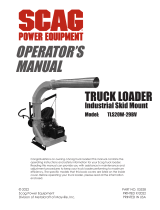 Scag Power Equipment TLS20W-29BV User manual
Scag Power Equipment TLS20W-29BV User manual
-
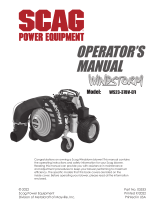 Scag Power Equipment WINDSTORM User manual
Scag Power Equipment WINDSTORM User manual
-
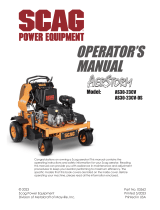 Scag Power Equipment AerStorm User manual
Scag Power Equipment AerStorm User manual
-
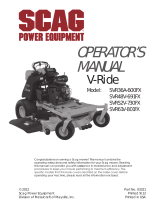 Scag Power Equipment SVR52V-23FX User manual
Scag Power Equipment SVR52V-23FX User manual
-
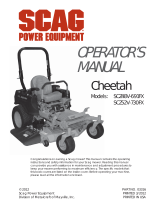 Scag Power Equipment Cheetah SCZ48V-23CV User manual
Scag Power Equipment Cheetah SCZ48V-23CV User manual
-
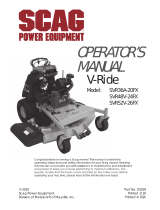 Scag Power Equipment SVR36A-20FX User manual
Scag Power Equipment SVR36A-20FX User manual
-
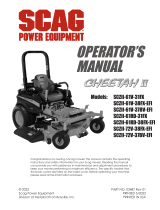 Scag Power Equipment Cheetah II User manual
Scag Power Equipment Cheetah II User manual
-
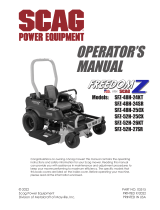 Scag Power Equipment Freedom Z User manual
Scag Power Equipment Freedom Z User manual
-
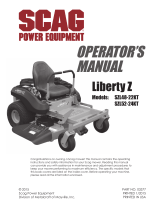 Scag Power Equipment Liberty Z SZL48-22KT User manual
Scag Power Equipment Liberty Z SZL48-22KT User manual
-
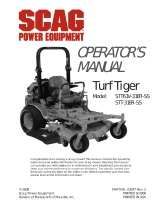 Scag Power Equipment STT-31EFI-SS User manual
Scag Power Equipment STT-31EFI-SS User manual
Other documents
-
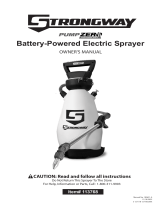 Strongway 190756 Owner's manual
Strongway 190756 Owner's manual
-
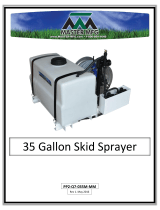 MASTER MFG PP2-Q7-035M-MM Owner's manual
MASTER MFG PP2-Q7-035M-MM Owner's manual
-
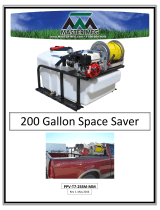 MASTER MFG PPV-T7-2SSM-MM Owner's manual
MASTER MFG PPV-T7-2SSM-MM Owner's manual
-
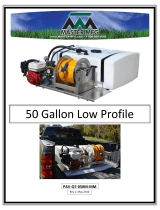 Valley Industries PAV-Q7-050M-MM Owner's manual
Valley Industries PAV-Q7-050M-MM Owner's manual
-
Toro Stand-On Spreader/Sprayer User manual
-
Toro Stand-On Spreader/Sprayer User manual
-
Toro Stand-On E-Spreader/Sprayer User manual
-
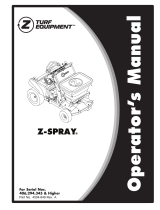 Exmark Z Turf Equipment Z-SPRAY User manual
Exmark Z Turf Equipment Z-SPRAY User manual
-
Toro Stand-On Spreader/Sprayer User manual
-
Toro Stand-On Spreader/Sprayer User manual



































































































